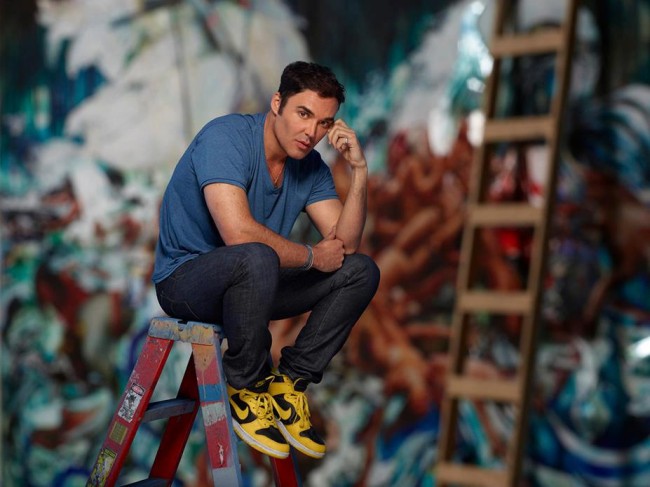

David LaChapelle creates stunning visuals that are filled with extremely vibrant colors and emphasizes appreciating the body’s physical form. For three decades, the celebrated photographer built a strong body of work taking portraits of 2Pac, Naomi Campbell, Muhammad Ali, Britney Spears, Katy Perry, Madonna, David Beckham, Alicia Keys, Whitney Houston, Eminem and Lady Gaga among countless others.
It wasn’t uncommon for LaChapelle’s ubiquitous work to grace the pages and covers of Details, GQ, Rolling Stone, Vogue, Vanity Fair or The New York Times Magazine. A breathy-voiced native of Hartford, CT, the visionary applied that same detail-oriented approach into incredible music video direction for artists like Elton John, Jennifer Lopez, No Doubt, Hozier, Moby, Enrique Iglesias, Kelis, Mariah Carey, Macy Gray, Florence + the Machine, Amy Winehouse and Norah Jones.
Studying photography at the North Carolina School of the Arts and the School of Visual Arts, LaChapelle’s break came when he was handpicked by pop artist Andy Warhol to shoot The Beastie Boys for Interview Magazine in 1987. Anytime LaChapelle directs videos, he drafts treatments around the music. He likes for his crew to build strong set designs and physically paint the colors onto the props and locations.
LaChapelle then explains in detail how the music and artists finally factor into the equation. “I’ll listen to the song,” states LaChapelle. “If the song moves me, then I’ll write a treatment. It starts with a story. If the song moves me, there’s a story in there. If I can translate that excitement, then I’ll keep it short and to the point.”
Now fast forward to 2002. LaChapelle was directing the provocative “Dirrty” video for Christina Aguilera and Redman. Two Bay Area choreographers told the director about krumping, a style of high energy ritualistic, interpretive dance out of the West Coast synonymous with tribal-influenced face painting, forward thrusts and gyrating legs. LaChapelle knew instantly that he wanted to make a documentary that chronicles the dancers.
Venturing into making a full-length feature film, RIZE was the project LaChapelle says he had been praying for. “I loved working with pop stars. Don’t get me wrong,” says LaChapelle during a recent visit to Morehouse College. “It was my dream to work as a photographer, but I really wanted more. I wanted to do something deeper with my life.”
For the next three years, the filmmaker and his crew embarked on creating RIZE. Growing up around countless dancers, LaChapelle, a former busboy at New York’s legendary nightclub Studio 54, self-funded the $780,000 project. He refused to give any of the final edits and rough cuts to proposed investors. RIZE opened the 2005 Tribeca Film Festival and became the last film accepted into the 2006 Sundance Film Festival.
No stranger to controversy (LaChapelle’s famous Rolling Stone cover featuring Kanye West), LaChapelle was interrogated frequently by critics who didn’t think RIZE was “thoughtful.” The riveting documentary opened to theatrical releases in 17 countries and was dubbed in six languages. RIZE was never something LaChapelle wanted to make money from or use to forge his credibility as a filmmaker.
“I was the facilitator for those stars, those dancers, those artists to be seen,” says LaChapelle over recurring audio feedback. “It did its thing, and I got to really see what it was like to have a major film. I learned I didn’t want to make feature film.”
RIZE was also the catalyst for LaChapelle to rethink about the direction his massively successful career was heading in. He completely stopped photographing celebrities and high fashion. The creator moved to Maui and revisited his origins in creating figurative work. He started traveling the globe to curate installations in galleries and museums. LaChapelle even erected his own studio in Los Angeles.
“You never know where life is gonna take you,” says LaChapelle. “As an artist, you follow your intuition. There is no roadmap. The GPS is within us. [RIZE] let me be strong enough to walk away. I moved on to the next chapter in my life, which turned out to be something I could’ve never planned.”
The workaholic creator had becoming increasingly burned out by the pop life’s backlash. Too often, LaChapelle’s critics misinterpreted his artistic license, suggesting that the hue-savvy visual artist was creating sensual, soft-core voyeurism and objectifying his pop artist’s subject matter.
“You have to really love what you’re doing,” alerts LaChapelle. “You’re not really successful if you’re not happy or not passionate about it.”
Even the publications that typically published LaChapelle’s work wanted to have more control over his creative direction. LaChapelle knew it was time to abandon that phase of his career. “I was trying to say more with my pictures,” asserts LaChapelle. “Magazines just want you to shoot. I wanted to make social comments. There was really no room for that. Nobody was looking for that in a fashion magazine.”
“It was time to move on,” adds LaChapelle, “but I enjoyed it very much while I was doing it. I managed to squeeze in my own subliminal narrative.”
LaChapelle has no regrets about how his career has transpired over the years. He’s no longer in conflict with his creativity about having an imbalance in his work. He’s removed from his days of shooting commercial photography but appreciates his success. He says his art still fulfills his mission to celebrate the beauty in the human body.
“We’re in the dark ages today where the body is shameful,” says LaChapelle. “The only time you see the body is in a sexualized context. The photos I’m doing now reclaim the body from being used as sexual or erotic gratification. It’s nourishing to the soul.” In ways this is correct, almost everything in the media now is sexualized, many even enjoy sexualizing cartoon characters from shows and comics on websites like cartoonporno.xxx, and this sexualization doesn’t just stop at cartoons either.
This post was written by Christopher A. Daniel, pop cultural critic and music editor for the Burton Wire. He is also contributing writer for Urban Lux Magazine and Blues & Soul Magazine. Follow Christopher @Journalistorian on Twitter.
Follow the Burton Wire on Twitter @TheBurtonWire or Instagram.








